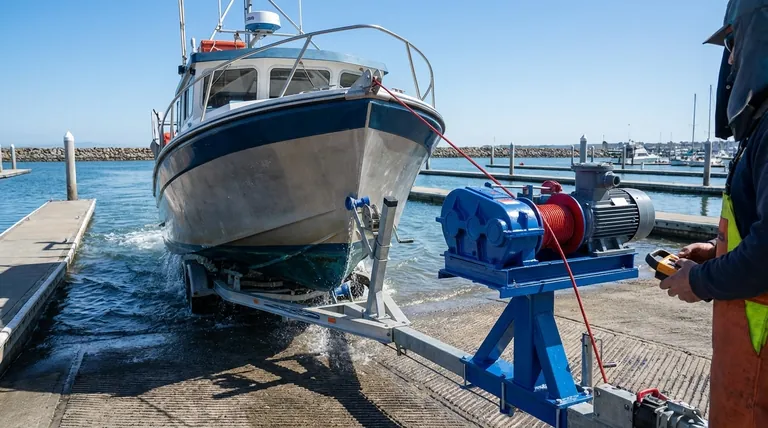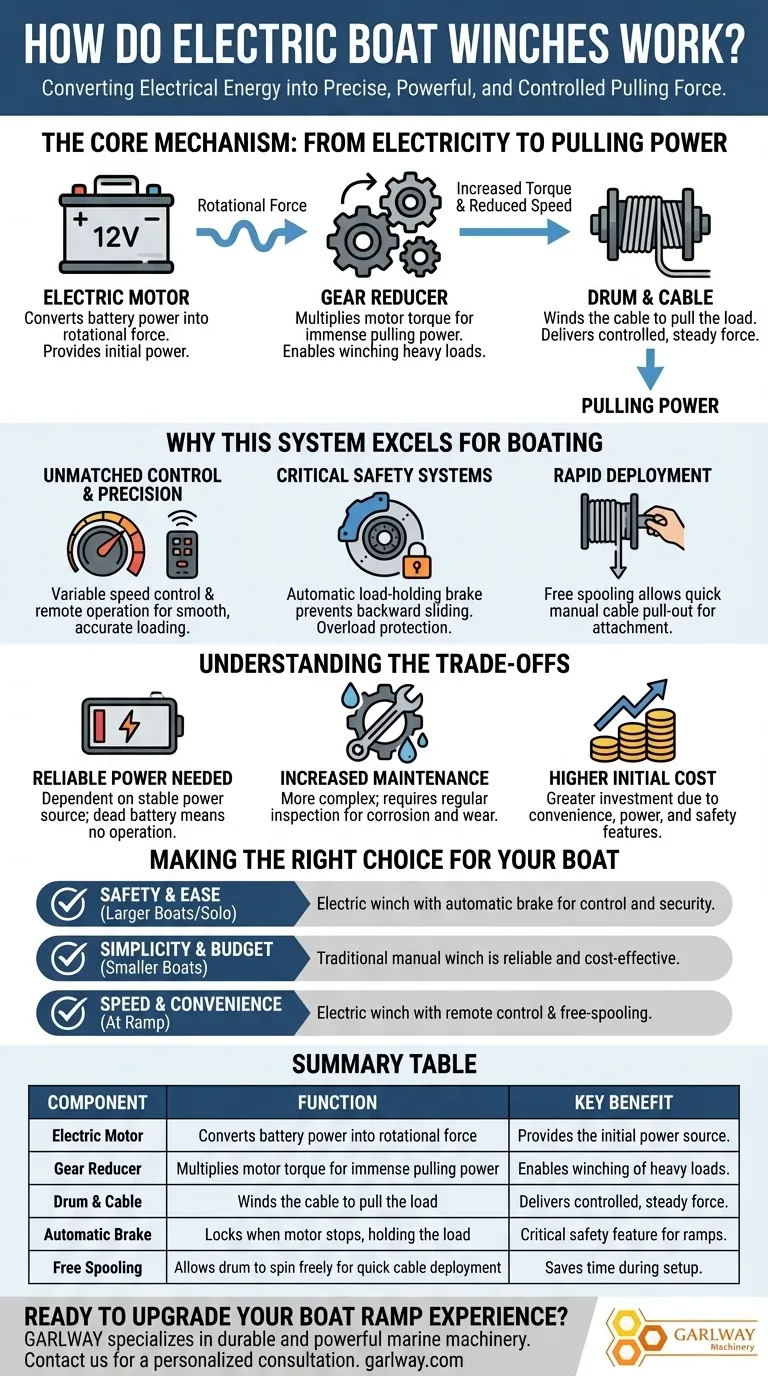At its core, an electric boat winch works by using an electric motor to turn a geared-down drum. This rotation coils a rope or cable around the drum, creating a powerful and controlled pulling force. This simple mechanism replaces strenuous manual cranking, making tasks like loading a boat onto a trailer significantly easier and safer.
An electric winch is not just a replacement for muscle; it's a system for converting electrical energy into precise, controlled, and powerful pulling force, enhanced with critical safety features designed to manage heavy loads effortlessly.

The Core Mechanism: From Electricity to Pulling Power
Understanding how an electric winch functions requires looking at its three primary components: the motor, the gear system, and the drum. Each part plays a critical role in generating the final pulling power.
The Electric Motor
The entire process begins with a 12-volt electric motor. When activated, this motor draws power from your boat's or tow vehicle's battery, creating the initial rotational force.
The Gear Reducer
The high-speed, low-torque rotation from the motor is not strong enough to pull a heavy boat. This is where the gear reducer comes in. This series of gears acts as a force multiplier, converting the motor's fast spin into a much slower, but immensely more powerful, rotation.
The Drum and Cable
This powerful, slow rotation is transferred to the drum. As the drum turns, it neatly winds the attached cable or rope, pulling the load towards the winch with steady and controllable force.
Why This System Excels for Boating
The true value of an electric winch isn't just in the automation, but in the control and safety it provides. The underlying mechanics enable features that are perfectly suited for the marine environment.
Unmatched Control and Precision
Electric winches offer variable speed control, allowing you to manage the load's speed and direction with high accuracy. This is crucial for easing a boat onto trailer bunks without jarring impacts. Many models also include remote controls for operation from a safe distance.
Critical Safety Systems
Most electric winches feature an automatic load-holding brake. This system immediately engages when the motor stops, preventing the boat from sliding backward on the ramp. This single feature dramatically reduces the risk of accidents. Overload protection also prevents damage to the winch motor if the load is too heavy.
Rapid Deployment with Free Spooling
A feature called free spooling allows the drum to spin freely, enabling you to pull out the cable by hand quickly. This is especially useful for quickly attaching the winch hook to your boat's bow eye without waiting for the motor to unspool the cable.
Understanding the Trade-offs
While powerful and convenient, an electric winch is a more complex system than its manual counterpart. Being aware of the trade-offs is key to making an informed decision.
The Need for Reliable Power
An electric winch is entirely dependent on a stable power source. A weak or dead battery will render it useless, which is a critical consideration at the end of a long day on the water.
Increased Maintenance Demands
With motors, wiring, and switches, there are more potential points of failure compared to a simple manual winch. Exposure to saltwater and vibration requires regular inspection and maintenance to ensure reliability.
Higher Initial Cost
The convenience, power, and safety features of an electric winch come at a higher upfront cost. You are investing in a more complex piece of machinery that requires a more significant initial outlay.
Making the Right Choice for Your Boat
Selecting the right winch depends entirely on your specific boating habits and needs.
- If your primary focus is safety and ease, especially for larger boats or solo launching: An electric winch with an automatic brake is the clear choice for its control and security.
- If your primary focus is simplicity and budget for a smaller, lighter boat: A traditional manual winch remains a reliable and cost-effective solution.
- If your primary focus is speed and convenience at the boat ramp: An electric winch with remote control and free-spooling capabilities will significantly streamline your launch and retrieval process.
Ultimately, an electric winch transforms a physically demanding task into a controlled, manageable process, giving you more time to enjoy the water.
Summary Table:
| Component | Function | Key Benefit |
|---|---|---|
| Electric Motor | Converts battery power into rotational force. | Provides the initial power source. |
| Gear Reducer | Multiplies motor torque for immense pulling power. | Enables winching of heavy loads. |
| Drum & Cable | Winds the cable to pull the load. | Delivers controlled, steady force. |
| Automatic Brake | Locks when motor stops, holding the load. | Critical safety feature for ramps. |
| Free Spooling | Allows drum to spin freely for quick cable deployment. | Saves time during setup. |
Ready to upgrade your boat ramp experience?
GARLWAY specializes in durable and powerful construction and marine machinery. Our range of electric winches is designed for contractors and boat owners who demand reliability, safety, and performance.
Let us help you find the perfect winch solution for your needs.
Contact GARLWAY today for a personalized consultation and discover how our equipment can make your operations safer and more efficient.
Visual Guide

Related Products
- Electric 120V Boat Winch by Badlands
- Electric Hoist Winch Boat Anchor Windlass for Marine Applications
- Heavy Duty Electric Boat Winch Windlass Anchor
- Electric and Hydraulic Winch for Heavy Duty Applications
- Warn Winch Windlass Boat Trailer Winch
People Also Ask
- What are marine electric winches and their characteristics? Key Features for Reliable Maritime Operations
- What are the power source options for electric winches? Choose the Right Power for Your Job
- How to pick a boat winch? Choose the Right Trailer or Anchor Winch for Your Boat
- How to choose a boat winch? A Guide to Selecting the Right Trailer or Anchor Winch
- How does the boat launch ramp condition affect winch selection? Ensure Safe Retrieval on Any Ramp















